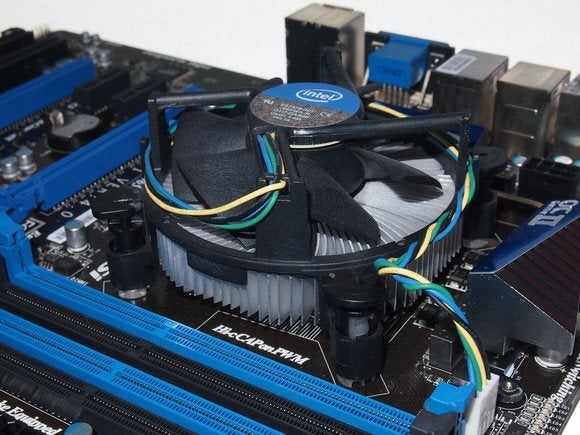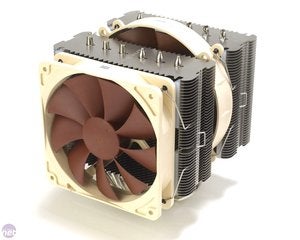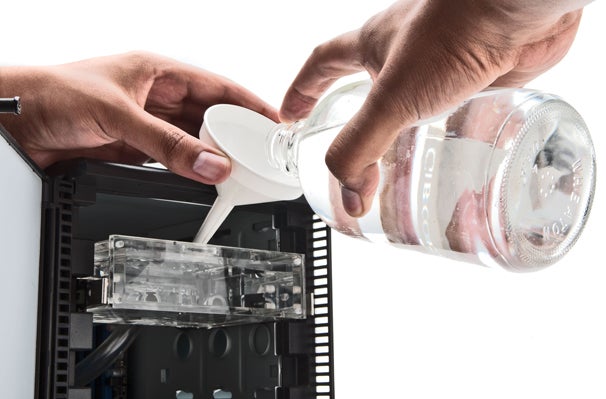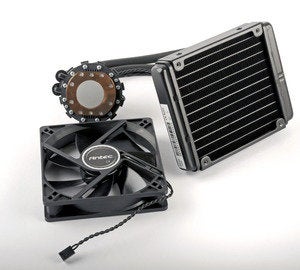All computer, from the smallest of home theater PCs to the most hulking of gargantuan play rigs, generates heating plant during operation—heat that can kill your PC's precious internals if you're not careful.
While you preceptor't have anything to worry about if you bought your estimator from a big-box retailer or straight from a manufacturing business like Horsepower, you'll be faced with a potentially material decision if you're building (surgery custom-buying) a fire-breathing, benchmark-feeding computer: Should you chill your PC with a traditional air cooling system solution or a pricier, yet more efficient liquifiable-cooling system system? That question has many aspects to consider before you can answer it.
Cooling methods explained
The secret to harnessing the cooling power of air lies in fans—lots of fans. Your typical beam-cooled PC is packed with case fans, graphics tease fans, and a CPU fan or two—positioned atop a queen-sized alloy heating system sink—to keep your expensive components nice and frosty.
A body of water-cooling system, happening the other hand, employs a series of coolant-full tubes, a radiator, water blocks (the equivalent of heat sinks), and few other components to keep your PC feeling refreshed. You'll straight need a a few fans to push around totally the H2O! Our guide to setting up a liquid-cooled PC explains a underlying (ha!) system in exacting detail.
Got it? Ripe. Defining air cooling and liquid state chilling is the easy part. The trickier bit is making the decision to use one operating theater the other.
Air cooling

One of the majuscule joys of using fans to cool your system is that, in a lot of circumstances, you genuinely don't have to make out anything to create a enough cooling system setup. If your arrangement's human body is of the non-bargain-bin mixed bag, odds are high that its maker has already installed exactly what you need—namely, an intake fan in the front that pushes open-air air over your hard drives and an exhaust fan that shoots hot vent flying KO'd of the rear of the material body.
Graphics cards and calculator processors pretty much forever ship with ruling stock fans—you know, the ones that sound like a plane taking off when they roar into action. Those, combined with grammatical case fans, make up the Holy Trifecta of air cooling within a typical screen background PC.
 Noctua
Noctua Thusly, the gigantic question cadaver: Why air? It's cheap, for unrivaled thing. Even if you privation to accompany an aftermarket cooler for your CPU or GPU, you'Re going to be paying far to a lesser degree you would for a liquid cooling system setup. The identical goes for case fans. You can certainly buy out bigger, amended, more than efficient fans if you want a quieter equipage, or even fans that light up if you're into that sort of thing. Sure, you'll have to invite them, but you'll silent expend far less cash upgrading Oregon building a nice air-cooling apparatus than you will on a typical water-cooling loop.
Likewise consider the cost to your sanity. It's a shell out easier to use cardinal screws to attach a fan to your case than it is to build your own water cooling setup.
Orthodox air cooling has three major downsides, though. Introductory, fans aren't as cost-effective American Samoa piddle cooling, which can pose a problem with seriously overclocked processors or in particularly beefy rigs filled with multiple graphics cards. Second, the heat sinks on powerful Central processing unit coolers can get big. Finally, fans are loud.
Water cooling pros
The act of switching from air to liquid cooling represents a personal milestone in one's computer-building life. You, young PC Padawan, are now a desktop Jedi.
 EKWaterblocks
EKWaterblocks Let's start with the pleasant bits. One of the cardinal benefits of a strong liquid cooling setup is that it allows you to fashionable specific scheme components to a greater degree than if were you to use fans—not the most applicable setup for individual running a typical stock-time CPU, only unrivalled that's definitely of involvement to anyone looking at to overclock their chips a snatch (or a short ton).
Even out if you father't tax your rig enough to want a bigger cooling boost, a catchpenny self-contained water chilling grommet—to a greater extent on those future—can help lower your PC's sound output. Water cooling is much quieter than stuffing your case full of fans.
On that point's also the issue of quad. A huge heat-drop/fan combination power perform asymptomatic enough, but the best CPU coolers eat up a ton of real estate inside your case. Smooth cooling system requires much inferior space, and it looks a lot niftier to boot. You can't discount the cool factor of a case full of colorful, liquid-occupied tubes!
Urine cooling cons

One big downside of water cooling is its comparatively high schoo cost, particularly if you're looking to frame a custom setup. While most traditionalistic pep pill-final stage C.P.U. coolers be somewhere between $50 and $100, building a liquifiable-cooling apparatus can toll far much. E.g., EKWaterBlocks' top-tier H3O 360 HFX water cooling kit costs a large $360. (The price is converted from euros, so the 360 in the advert may be coincident.)
Quality matters in a liquid-cooling setup: You don't want to steal tatty parts to save a few bucks and finish up dousing your costly PC components in brilliantly hued coolant.
The homework involved is another drawback. Generating the parts list is going to take a little planning if you're non buying a prepackaged kit. You'll have to pickaxe dormy a water stoppage for your CPU that fits its socket, fittings that match your block and tubing size, the tube itself, a pump, a reservoir, a radiator, a fan (or fans) for the radiator, and the coolant itself. And that's just a typical apparatus for the most bare-bones shape you can build. If you want to top executive unintegrated loops for your video card, motherboard, RAM, or toilsome drives, you'll wealthy person to exercise even more planning and buying.

You'll also bear to produce secure you have room for your frame-up. Radiators typically require open sports fan slots connected your case. Reservoirs require space in your case as well, and you'll consume to design out your loop's layout so that you can buoy really get information technology up and running ("priming" the pump, so to speak) when you fill it with coolant. In other language, your water-cooling loop does you no good if you don't have a good direction to scram the fluid gushing around!
Then at that place's the installation itself. Simply put, your first adventures in water-cooling land could very fountainhead be fraught with peril. Installing loops International Relations and Security Network't exactly starter-friendly, and the process might be more involved than you're comfortable with, even if you've installed a typical fan-based aftermarket CPU cooler or two.
Which reminds me: Connecting your tubing and fittings in a secure and safe fashion is going to be your number-one exit when building your first water-chilling setup. You will spring a leak in some style. You'll want to conception and test your limpid-cooling system system outside of your PC to check its fortitude in front installing information technology around your valuable electronics. Component manufacturers aren't likely to replace flooded electronics, and the manufacturers of your water cooling parts for sure aren't going to foot the bill.
Self-contained molten coolers

If all this talk of water cooling's complexity has left your head teacher spinning a bit, fear not: Another solution is available.
Someone-contained or "sealed" liquid-cooling kits—preassembled and completely paved, they start at roughly antimonopoly $60—allow you reap the benefits of a simple water-cooling setup without having to deal with any of the untidy particulars. You righteous need to bond a urine stoppage to your CPU and a radiator/fan combination to your case, and you're remove to the races, with no a drop of coolant to worry nigh. You may lose customization options if you use ego-contained kits like Barbary pirate's Hydro H-series or NZXT's Kraken-series coolers, simply you besides lose most of the headaches typically associated with do-it-yourself melted chilling. Escape is highly unlikely as long As you preceptor't twist Oregon twist the tubing at fulgurating, weird angles.
Installing a self-contained liquid-cooling kit is around on a equality with the difficulty of installing an aftermarket cooler for your CPU. If you need to water-cool only your overclocked processor, a sealed liquid ice chest is a compelling option. Stick to DIY loops if you want to liquid-cool more than the single component, nevertheless—or if you deficiency the bling factor of clear tubes full with colorful coolant. Most sealed coolers are opaque.
Last
So, which is better? Line cooling or water cooling? The answer depends along your particular employment inevitably.
One size does not scene every last when IT comes to case cooling, only most people can get by with fans alone. It's easy, and it's cheap. If, then again, you're an enthusiast who needs the best temperature reduction likely for your flaming CPU and a gaggle of graphics cards, a DIY water-cooling setup is in your future. Finally, essay a sealed liquid cooler if you're considering liquid cooling either to hold up your overclocked central processor chilled or simply to benefit from shriveled system noise.
Which Is Better for Cooling Pc Fans or Liquid Cooling
Source: https://www.pcworld.com/article/456855/liquid-cooling-vs-traditional-cooling-what-you-need-to-know.html